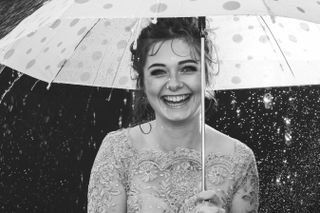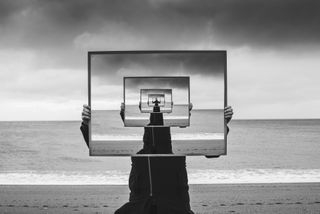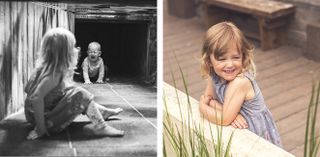Portrait photography how to: 14 tips for getting your best ever people shots
Our portrait photography how to walks you through some essential techniques for photographing people

• A 'portrait' lens is not essential but can help you create flattering facial perspectives and defocused backgrounds. See best portrait lenses
• A flashgun is great for adding 'fill-light' in sunshine or lightening dark interiors. See best flashguns
• Studio lighting kits are a serious investment, but the next step up for commercial portrait photography. See best lighting kits
• Ring lights give a soft, even glow and have become really popular for portraits. See best ring lights
• Reflectors are a super-useful, low-tech way of bouncing light into the shadows. See best reflectors
Our portrait photography how to is for all kinds of photographers, shooting styles and experience levels. When it comes to taking portraits, there are many different ways to go about it – so there are plenty of great portrait photography tips to learn, whether you are capturing candid moments out on the streets or putting together skilled lighting setups on location. They don't all require expensive equipment, technical know-how or studio setups
The genre ‘portraits’ sits under a huge umbrella with various kit, skills and knowledge needed for alternative approaches. However there are many portrait photography tips that transpire across all the different methods, so whether you’re just starting out with your camera or have been doing it for a while, make sure you follow these top tips to take your portrait photography to the next level.
• Newborn photography tips
1. Background matters

It's not just about your subject! The first rule in our portrait photography guide is that the background is just as important as the subject in the frame. The setting you choose for your subject can reveal a lot about them—whether they are in a studio, a familiar environment, out on location, or at their workplace. These decisions should be carefully considered to enhance your portrait and convey the story you want to tell about your subject.
Blurred backgrounds are often ideal for portraiture as they help to isolate your subject and make them stand out. If your lens’s aperture setting doesn’t open as wide as you'd like, try bringing your subject forward and away from any surfaces to enhance the background blur. This technique can create a pleasing separation between your subject and the background, adding depth to your image.
When shooting outdoors, it's easy to get distracted by your subject's pose and facial expressions and miss potential distractions in the background, like a tree appearing to sprout from their head.
Always be mindful of such obstructions while shooting to avoid disappointment during the editing stage. A well-composed background will complement your subject and elevate the overall quality of your portrait.
• 215 photography tips, video tutorials and techniques
2. What are the eyes doing?

The eyes are the key to the soul and the connection to the audience. Even if the eyes are closed this says something about the subject, for example, are they shy, worried or perhaps thoughtful. If the eyes are looking into the lens make sure they are pinpoint sharp (closest eye if your subject is at an angle). Use a single AF focus point and select it manually to be sure you are spot on.
• 66 tips cards for posing and lighting portraits
3. Candid approach

There is nothing more satisfying than capturing your subject in a genuine, unstaged moment. This is why the fly-on-the-wall and informal candid approach is so beloved in portraiture. A 50mm lens is often an excellent choice for candid shots as its angle of view closely mimics what our eyes see, allowing you to quickly observe and compose your shots.
To achieve great candid captures, you must be fully observant and able to anticipate your subject’s movements. By predicting their actions, you increase your chances of snapping that perfect, spontaneous moment. With the right timing and keen observation, you'll be sure to capture the ultimate candid shot.
• The best books on street photography
4. Camera settings for portraits

When it comes to shooting portraits, your basic camera settings are crucial. We recommend setting your camera to Manual mode for full control. Begin with the aperture setting to determine how much of the face you want in focus.
For close-up headshots, an aperture of f/1.8 will create a very shallow depth of field, blurring most facial features. Starting at f/5.6 might be better, allowing you to adjust as needed. For wider shots, you might start with a wider aperture like f/2.8, then adjust based on how much background blur you want.
After setting your aperture, balance your shutter speed and ISO. To avoid motion blur, use a shutter speed of at least 1/200 sec, or 1/500 sec for faster-moving subjects like children and animals.
For a quick and efficient approach, set your ISO to Auto ISO, which will automatically adjust to the lighting conditions. You can limit the Auto ISO to a maximum value, such as ISO 1000, to minimize noise in your images. This balance ensures you capture sharp and well-exposed portraits.
5. Break the norm

When it comes to finding an alternative approach to portraiture don’t be afraid to go abstract! Take for example this image here which uses the frame in a frame in a frame idea.
Photoshop is a wonderful tool and can be used in conjunction with the portrait genre to create some great results. For those who don’t want to spend as much time at the editing stage mirrors also work well on location with a portrait subject.
• The best photo editing software
6. Lens choice

What lens you pick will determine the look and feel of your portrait. Long lenses (for example 70-200mm view) are great for portraiture as they compress facial features for a flattering result. They can also blur the background more further isolating the subject.
Wide angle lenses are traditionally not used for portraiture, however they still have their uses. If you want to shoot environmental portraits then a wide angle lens might be better. Placing people in their environment surrounded by their possessions or hobby reveals so much about them.
If using using a wide angle lens around 15-35mm then make sure your subject is comfortably in the middle of the frame and not close up on the face as it may distort their features.
• Best cameras and lenses for portraits
7. Flashgun recycle time

A flashgun is a great photographic accessory for portraiture that can be used remotely as it is small and portable to carry, plus powered by battery without the use of mains. If you have the budget to invest get a couple of units as it will open up your creative possibilities.
When it comes to setting the strength of your flashgun if the light allows you we advise you reduce the power down to 1/4 setting or lower and increase the ISO on your camera. That way your flash’s recycle time will be much faster allowing you to shoot faster, which in portraiture is vital.
8. Natural light

You don’t need loads of expensive lighting gear to get professional-looking results. The natural light is great and easy to work with and more importantly it’s free! Grey cloudy days are perfect for portraits as the clouds act like a big diffuser panel.
Sunny days are fine too however avoid the midday sun (especially in the summer) as the light is hard and tricky to work with, and can cause unflattering shadows. On bright sunny days we recommend placing your subject in shaded areas.
A great tip when positioning your subjects is to spin them around in a 360-degree circle to see how the light falls on their face for the optimum result.
9. Editing tips

The file that comes directly out of a camera (especially a raw uncompressed one) is never going to look as good as an edited one. Editing allows us to bring back emotions to our portraits and also tidy up unwanted skin blemishes and spots.
Photoshop is a good tool to use for cleaning up marks and spots on the face however remember not to go too far with your beautifying. Although we can remove every line, crinkle and flaw from your subject you want your sitter to still look like them and not an alien!
10. Communication, collaboration and posing

Remember that taking a portrait is just as much about the subject as the photographer! Your subject will reflect your behaviour and directions so be clear in what you want to achieve. If your technical skills still require more thinking keep practicing with your camera to get more familiar and comfortable with it.
Once you can get past having to think about your camera settings you can focus more on your subject and their posing and position. Remember everyone has to start somewhere and we all have failed portrait photoshoots - that is how you learn! Talk with your model beforehand and ask them to be patient with you. That is harder with children though!
11. Photographing children

They say never work with children but what an opportunity you’re missing out on if you don’t. Firstly kids are fun - such good fun. They have tons of energy and many of them love to perform in front of the camera.
The trick is trying to capture them in those candid moments where they’re unaware of you taking a photograph. Keep them busy and if they have loads of energy let them jump it out, run towards you and spring around. Often the second part of your shoot is when you’ll capture the winning shots once they’ve dispelled some of that initial energy.
Set your focus setting to the AF tracking feature so when they’re darting left, right and centre so you never miss a moment.
Also don’t be afraid to capture them when they’re not smiling, after all this is part of who they are as well! Many parents like to have a mixture of images that reflect reality rather than cheesy staged ones.
12. Wrinkles and crinkles

There are certain subjects that lend themselves to the portrait genre. Older people with a story to tell and texture on their face are brilliant subjects to photograph. Try converting your image to monochrome to make the most of the textures and push the contrast up to enhance the black and white tones.
13. Location portraits

It’s tempting to stay indoors when it comes to portraiture as there is less to logistically oraginse, however heading out on location opens up many creative opportunities. This photo shoot of ballerina Lydia Brayshaw was taken on a secluded beach in Devon.
The idea behind the shoot was for Lydia to dance with the scenery blending the idyllic beach scene and the ballet together. The warm glowing evening summer light was a key part of the feel for the images and no flash was used.
14. DIY kit

You don’t need much to help enhance your portraits. A 5-in-1 reflector is a useful accessory however if you don’t have one you can easily make one out of card and tinfoil to bounce light back into the shadows.
Equally a piece of white card close to the face will pick up features or if you want to darken the shadows for a moody result you can use a piece of black card to flag the light.
• The best reflectors for photography
Portrait photography video tutorials
• Studio portrait lighting: essential tips and setups explained
• Headshot photography tips: shoot the perfect head-and-shoulders portrait
• Couple photography: poses for portraits of pairs of people
• Fine art nude photography: tips and techniques
• Boudoir photography tips: lighting, posing and camera skills
• Fill-in flash: tips and tricks for using a flashgun in daylight
• Perfect the strobist look with off-camera flash photography
• Bounce flash: tips to achieve natural lighting with a flashgun
• Gobo lighting: tips for dramatic portraits and film noir photography
• Baby portraits: get great shots with these baby photography tips
• Take a great group photograph: tips for posing perfect people shots
• Commercial headshot tips: professional portrait photography with a single light
• Portrait photography tips: how to practice portrait lighting without a model
• Key lighting and fill lighting for portrait photography
Read more:
• The best camera for portraits: cameras and lenses perfect for portraits
• The best books on portrait photography
• How to use a light meter (and why not to trust the camera meter!)
• Best light meters
• Boudoir photography tips and techniques
Get the Digital Camera World Newsletter
The best camera deals, reviews, product advice, and unmissable photography news, direct to your inbox!
Claire is a professional photographer and writer, and lives by the the sea with her two young children, husband and cat in the southwest of the UK.
After graduating from The Bournemouth Arts Institute with a first-class degree in photography, Claire worked for a number of years in the publishing industry, including as Technique Editor for Digital Camera magazine.
She loves anything and everything to do with photography, from creating magazine articles to photographing ballerinas on the beach and newborn babies (but not at the same time). She mainly shoots with digital DSLRs, but does dust off her beloved Hasselblad medium-format film camera once in a while…
